What Is The Best Penn Spinning Reel?
UPDATED 11 MAY 2023
by Robert Ceran
This article may contain affiliate links. If you make a purchase after clicking on a link we may earn a small commission at no extra cost to you.
Are you looking for a new Penn spinning reel, but aren’t sure which model offers the best value for you?
My team and I tested the most popular Penn spinning reels on the market, and evaluated them on their gear ratio, retrieve rate, weight, drag pressure, and overall performance.
Based on our testing, here are our picks for the top Penn spinning reels in 2023:
- Best overall: Penn Spinfisher VI
- Best budget: Penn Pursuit III
- Best for beginners: Penn Fierce III
- Best for freshwater: Penn Battle III
- Best for saltwater: Penn Slammer III
- Best ultralight: Penn Conflict II
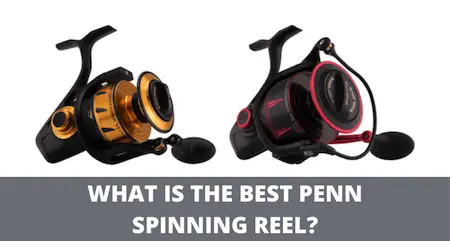
Best Penn spinning reel reviewed
The table above compares the main specs and features of the top 5 penn spinning reels that we tested side by side.
Based on our testing, these are the 5 best models, as they cover the most important fishing applications between them.
Now let’s look at each of these in more detail, while also looking at several additional models that are worth mentioning.
1. Penn Spinfisher VI
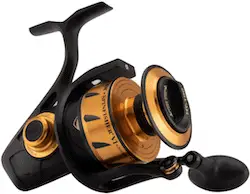

For us here at Sportfishing Buddy, the Penn Spinfisher is hands down the best spinning reel made by Penn, and also the best Penn spinning reel for the money.
This model is only 20 to 30 dollars more expensive than the Battle, but provides a really significant upgrade in terms of its construction and features.
It comes with an all-metal build, which automatically makes it stronger and more durable than most lower end models made with graphite and lots of plastic.
In addition, the reel frame and the spool are sealed with IPX5 sealing, which means it’s basically watertight.
While testing the Spinfisher VI, we found that you can actually dump this fishing reel in seawater and submerge it completely – as long as you don’t leave it in the water for a long time, and then rinse it off afterwards, it’s good to go.
Our testing revealed that another advantage compared to the Penn Battle is that you get a sealed drag system. This is different from the regular HT 100 drag system and makes it much more resistant to salt water.
So, with this spinning reel you have a significantly more durable drag system than you do with the Battle, which means you get a lot of extra value for a relatively small amount of extra money.
For a detailed comparison of the two reels, check out our review: Penn Spinfisher vs Battle.
When we put it to the test, we found that the only minor downside of the Spinfisher is that it is a little on the heavy side (especially compared to the Conflict), which is due to its all-metal construction.
But in our opinion, its advantages far outweigh this single disadvantage, and make it the number one most popular Penn spinning reel among many, many anglers.

Features:
- CNC gear technology
- All-metal construction
- IPX5 sealed body & spool
The Penn Spinfisher also comes in two additional variants:
Penn Spinfisher Long Cast: This model is very similar to the basic Spinfisher, but comes with an extra large, elongated spool. This spool design enables extra long casting, which makes this spinning reel perfect for surf fishing.
Penn Spinfisher Live Liner: This model is also similar to the Spinfisher, but comes with a secondary drag system that serves as a bait clicker system that allows fish to pull line off your reel easily before you set the hook, which makes it ideal for live liner fishing with live bait.
The secondary drag is controlled via a separate control knob at the back of the spinning reel. You can easily switch back and forth between the two drag systems with a lever on top of the reel frame.
2. Penn Fierce III
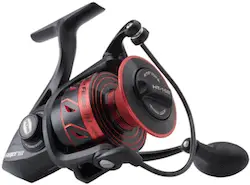

Many anglers view the Penn Fierce as a basic workhorse fishing reel that can be used for many standard applications.
It comes with shielded bearings, and a good solid felt drag system. When we put it to the test, we found that the only disadvantage is that it has a plastic rotor, but that may not be a big deal for some anglers.
After testing it, we found that this spinning reel provides excellent value at a very low cost, which makes it an ideal choice for beginners.
So if you’re just getting into fishing, then start with a Fierce. In many ways it’s just as good as the Battle, but costs significantly less because it’s made of cheaper materials.
Once you get to like the Penn Fierce, then it’s time to start thinking about upgrading to the Battle, or even a Spinfisher, depending on your specific fishing needs and tactics.

Features:
- Techno-balanced rotor
- HT-100 carbon fiber drag
- Metal body and side plates
3. Penn Slammer III


With the Penn Slammer you get the Dura drag system, which is the same type of drag that’s used in the Penn conventional reels (their big round casting reels that are used for big game offshore fishing, such as tuna or marlin fishing).
So with the Dura drag system you get a lot of additional drag power, which is significantly more than offered by the other Penn spinning reels.
The Penn Slammer also has the IPX6 water sealing system. This makes it more watertight than the Penn Spinfisher, which has IPX5 sealing. During our testing, we found that we were able actually put this spinning reel underwater in saltwater and rotate the handle without water getting inside of it.
Also, in addition to the CNC machined gears, there are a lot of brass components used for the internal parts, which are more durable and resistant to warping under pressure than aluminum.
So overall, the Slammer boasts high quality corrosion-resistant components on the inside, as well as the IPX6 water sealing system to prevent saltwater getting into it in the first place.
Our testing revealed that this construction makes it one of the most durable and reliable saltwater fishing reels on the market, and it is an ideal choice for offshore fishing as well as any ocean fishing where you’ll get a lot of exposure to saltwater.

Features:
- All-metal construction
- IPX6 watertight sealing of body and spool
- Sealed Dura drag
4. Penn Conflict II
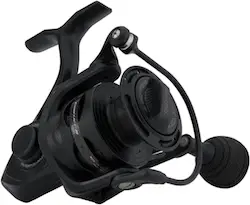

The Penn Conflict is a relatively new reel from Penn and it’s pretty unique compared to the other spinning reels in their lineup.
Our tests showed that the biggest distinguishing feature of the Penn Conflict is that it is a lot lighter than the other Penn models, which is due to the use of carbon graphite for its main parts.
Penn developed their own proprietary blend of carbon fiber, called RR 30, and both the frame and the rotor are made of this. In contrast to the frame, its handle is made of aluminum, and comes with a round EVA knob.
Most anglers agree that the Conflict is one of the most elegant and attractive Penn spinning reels.
But one thing you should note is that this is not a sealed spinning reel like the Spinfisher. So if you submerge it in saltwater and you don’t open it and clean it right away, it will definitely seize up on you.
Another strong point of the penn Conflict is that it has CNC machined gears, which has the advantage that the quality of the machining process is higher compared to the lower end models, and our testing confirmed that this makes its gear performance better and more reliable.
In concrete terms that means it is a smoother spinning reel that has less warp under high pressure.

Features:
- Lightweight build with all-graphite RR30 body and rotor
- CNC gear technology
- 7 plus 1 sealed ball bearings
5. Penn Battle III
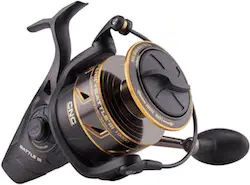

The Penn Battle has a metal frame and a metal rotor, so compared to the Penn Fierce and the Penn Pursuit, it’s clearly a step up in terms of strength and durability.
And while it also has sealed ball bearings on the inside, our testing showed that it is definitely not a waterproof fishing reel, unlike some of the higher end Penn models (see below).
So if you dunk this reel in saltwater and don’t open it up to clean it immediately, it will definitely seize up on you.
The Penn Battle has one additional ball bearing compared to the Fierce, but what matters most to the majority of anglers is how smooth the spinning reel feels and most people can’t really tell the difference between a Fierce to and a Battle in terms of smoothness.
If you want to compare the two models in detail, check out our review on Penn Battle vs Fierce.
The second big difference that our testing revealed between the Penn Battle and the Fierce is that it comes with the HT 100 drag system, which utilizes carbon drag washers.
That’s a big upgrade compared to the Fierce, since the difference between felt washers and carbon washers is clearly noticeable when you’re fighting a big fish. Overall, this makes it the best Penn freshwater spinning reel in my opinion.
With that being said, the Battle is also strong enough to handle big fish, including in nearshore saltwater environments.
So, if you like to catch bull reds or amberjacks, you need a strong reel like the Battle, which explains why it’s currently the most popular Penn 6000 reel among many anglers.
And while our testing showed that you can take the Penn Battle offshore to catch spanish mackerel or wahoo, keep in mind that it’s not designed to withstand lots of saltwater exposure.
In some cases that doesn’t matter, since you won’t get a lot of spray coming over the side, in which case the Battle will have you covered.

Features:
- All-metal construction
- HT-100 carbon fiber drag
- 4 plus 1 stainless steel ball bearings
6. Penn Clash II
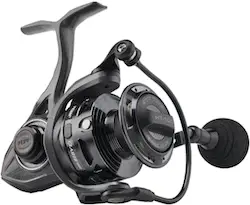

The Penn Clash has the same CNC machined gears and the same drag system as the Penn Conflict, but unlike the Conflict (which has an all-graphite build), the Clash has an all-metal construction.
So it’s heavier and more durable, and you can fight bigger game fish on it. But otherwise there’s really not much difference between the Clash and the Conflict, aside from the fact that it’s all metal.
And while it comes with sealed ball bearings, when we tested the Penn Clash, we found that it is definitely not a watertight reel, just like the Conflict isn’t watertight, which makes both reels a little vulnerable to saltwater exposure.
So based on our test results, the Spinfisher is really unique in this regard, by providing a sealed spinning reel at a relatively affordable price.

Features:
- Full-metal body and sideplate
- HT-100 carbon fiber drag
- 8 plus 1 stainless steel ball bearings
7. Penn Pursuit III
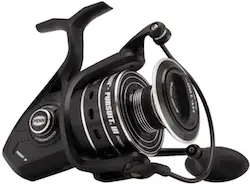

This is one of the most affordable Penn spinning reels, and it’s clearly intended as an entry level model.
It has very basic features, and comes with a felt drag system and only a couple of ball bearings. In terms of build material, the Penn Pursuit is made out of graphite combined with a lot of plastic.
After testing it, we found that the reel construction is clearly not designed for saltwater fishing, since none of its components are shielded or sealed. So the Penn Pursuit is definitely not the best choice if you want to go saltwater fishing.
But if you’re just starting out as an angler, and not sure if you really like fishing yet, then this spinning reel could be a good choice, since it doesn’t require investing a lot of money.
Having said that, in terms of value you’ll get a lot more out of the Penn Fierce, which only costs a few dollars more than the Penn Pursuit.
Even experienced anglers like to keep a Fierce or two around at all times, and you’ll enjoy your fishing experience a lot more with a Fierce.

Features:
- Lightweight graphite construction
- HT-100 carbon fiber drag
- 4 plus 1 ball bearings
8. Penn Torque II
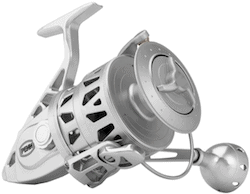

The Penn Torque is the most high-end spinning reel produced by Penn and definitely looks strikingly elegant with either a golden, or a silver finish (depending on your preference).
However, you need to know that it starts at $700, which is why very few anglers own a Torque.
Based on our testing it was hard to tell what makes the Torque so much better than the Slammer, since they share most of their features and technical specs, including all-metal build, Dura drag, and IPX6 water sealing.
One notable difference that our testing revealed is that the Torque is noticeably smoother than most other spinning reels on the market, due to the fact that it has 10 ball bearings, (which is more than any other Penn spinning reel, including the Slammer).

Features:
- All-metal construction
- IPX6 watertight sealing of body and rotor
- 9 plus 1 stainless steel ball bearings
Best Penn spinning reel for saltwater
Based on our testing, the Penn Slammer III is the top Penn saltwater spinning reel currently on the market.
While the Penn Spinfisher is also a great saltwater spinning reel, the Slammer beats it in this category, and is currently one of the very best saltwater fishing reels available.
There are 3 main features that make the Penn Slammer ideal for saltwater fishing:
- All-metal construction, including CNC machined brass gearing and internal parts
- IPX6 watertight sealing
- Sealed Dura drag system
Let’s look at each of these features in more detail:
The all-metal construction of the Penn Slammer makes it automatically more durable and resistant to warping under pressure than most lower end spinning reels, and this is essential if you’re targeting big saltwater fish that put up a hard fight.
The IPX6 sealing provides the highest degree of watertight sealing that Penn makes, and this enables the Slammer to easily handle exposure to lots of saltwater on a regular basis – conditions that would cause most other spinning reels to seize up very quickly.
Finally, the dura drag system on the Slammer provides exceptional fighting power.
It is the same drag as the one used on the big Penn conventional reels, which gives you loads of power to catch big ocean fish.
Best Penn reel for surf fishing
In our tests, the Spinfisher Long Cast Spinning reel performed as the best Penn reel for surf fishing. It is specifically designed to enable extra long casting distances with an elongated spool design that holds more line, and releases line with less friction during the casting process.
Long casting ability is one of the key abilities that any surf fishing reel must have.
And while Penn has another spinning reel model with long cast design, the Penn Conflict Long Cast Spinning reel, this model is less suitable for surf fishing because it doesn’t have sealing technology, which makes it much more susceptible to damage by exposure to saltwater.
The second key feature of any surf casting reel is the ability to withstand regular exposure to saltwater spray, or even immersion in seawater, and the Spinfisher Long Cast is perfect for this, due to its all-metal construction and IPX5 sealing technology.
But you need to be aware that you can’t turn the handle of the Spinfisher underwater because that would cause water to get inside of it.
And one disadvantage of a sealed spinning reel is that if water does get inside it, it’s really hard to get it out again. So make sure you don’t turn the reel handle underwater.
Penn Slammer vs Spinfisher
When we compared the Spinfisher vs Slammer it immediately became clear that both are among the best Penn saltwater spinning reels – they both have all-metal construction and IPX sealing to make them waterproof. But what distinguishes them from each other?
There are two main differences between the two reels:
- The Penn Slammer has IPX6 sealing, which is more advanced than the IPX5 sealing of the Spinfisher, and makes it more resistant to saltwater exposure. So, while both reels can be dropped into saltwater without being damaged, the handle of the Slammer can actually be reeled underwater without any problems, while doing that with the Spinfisher would cause it to get waterlogged.
- The Penn Slammer has a more powerful Dura drag system with 30 – 60 lb max pressure, while the HT-100 drag system of the Spinfisher only has 15 – 50 lb max pressure. This makes the Slammer better for targeting trophy sized ocean fighters.
Bottom line: the Slammer is more resistant to saltwater exposure than the Spinfisher, and also has more drag power for fighting big fish.
This makes it ideal for the extreme conditions of offshore fishing, while the Spinfisher is great for inshore fishing, where you would usually have less saltwater exposure, and catch smaller fish on average.
Penn Clash vs Slammer
While both the Penn Clash and Slammer have an all-metal build and CNC machined gears, that’s where the similarities end. Unlike the Slammer, which is completely waterproof with IPX6 sealing, the Clash is not a sealed spinning reel, which makes it vulnerable to saltwater exposure.
Also, the Dura drag of the Slammer has 30 – 50 lb max pressure, compared to the HT-100 drag of the Clash, which has 9 – 15 lb max pressure. The Slammer drag obviously has a lot more power for fighting big fish.
Bottom line: if you’re looking for a really good saltwater spinning reel, or want to catch trophy sized fish, the Penn Slammer is definitely a better choice.
On the other hand, if you’re looking for a lightweight freshwater fishing reel, then the Penn Clash could be the one for you, since it starts at a 1000 size (while the Slammer starts at 3000).
Penn Clash vs Conflict
Overall, the Clash and the Conflict are very similar reels, and their main difference is that the Clash is made with all-metal construction, while the Conflict is built with RR30 carbon graphite resin.
As a result, the Conflict is significantly lighter than the Clash (and is in fact the lightest spinning reel made by Penn).
Here is their weight range compared:
- Clash: 8.2 to 27.2 oz
- Conflict: 6.3 to 14.4 oz
Since neither of these spinning reels has sealing technology making them resistant to saltwater, you should use them primarily as freshwater reels.
And in that case, the Conflict would be our recommended choice, since its graphite construction provides a big advantage due to its lightness. This is especially important if you plan to cast and retrieve lures all day long.
Bottom line: the Penn Conflict is significantly lighter than the Penn Clash, and is therefore better suited for lightweight freshwater applications.
But in case you’re looking for a saltwater reel, then neither of these models is the best option, and you should be looking at the Penn Spinfisher or Slammer instead.
Penn Conflict vs Battle
There’s about a $40 price difference between the Penn Battle and the more expensive Penn Conflict, and you may be wondering why this is, and if it’s worth paying extra for the Conflict.
Here are the three main differences between the two reels:
- The Conflict frame is made of graphite, making it significantly lighter than the all-metal Battle.
- The Conflict has 7 ball bearings, which makes it smoother than the Battle, which has 5 bearings.
- The gears of the Conflict are machined with CNC technology, which makes them smoother and more durable than those of the Battle.
Overall, these features make the Conflict worth the extra money compared to the Battle if you’re looking for a smoother, more durable, and lightweight reel.
But it’s important to note that neither of these two reels has sealing technology, and are therefore not the best choice for saltwater fishing.
If you’re looking for a saltwater reel, we recommend either the Spinfisher or the Slammer as better choices.
Penn Conflict vs Spinfisher
In terms of pricing, these two reels are very similar (both starting around $150). But otherwise they are very distinct from each other, and are best used for very different purposes.
The three main differences between the two reels are:
- While the Penn Spinfisher is built with all-metal construction, the Conflict is built with graphite carbon, which makes the former more durable, and the latter more lightweight.
- While the Spinfisher has IPX5 sealing technology on its frame and spool, the Conflict has no sealing, which makes the Spinfisher a much better choice for saltwater fishing.
- The Penn Conflict has 7 ball bearings, while the Spinfisher only has 5, which makes the retrieval action of the Conflict noticeably smoother.
Based on these differences, it’s clear that the Spinfisher is by far the better choice for any saltwater applications, while the Conflict is the better choice for freshwater tactics that involve casting lures all day long, where its lightness of weight really makes a difference.
Penn Torque vs Slammer
Both the Penn Torque and the Slammer are designed as high end saltwater reels, but the Torque retails at more than twice the price of the Penn Slammer. This raises the question: what makes it different, and is it really that much better?
But if you examine the specs of the two reel models, they seem to be almost identical. They both have an all-metal construction, CNC machined gears, IPX6 waterproof sealing, and a sealed Dura drag system.
So what actually distinguishes them from each other? We can only find two real differences:
- The Torque has 10 ball bearings, which is more than any other Penn spinning reel, and makes it smoother than the Slammer, which has 8 bearings.
- The Torque has a very elaborate and stunning design, which comes in either all-silver or all-gold finish.
So overall, it would seem that a large part of the extra cost of the Torque is due to its more elaborate design and elegant appearance, which makes it attractive to “connoisseurs” that like to collect high end fishing reels.
But otherwise, the Penn Slammer can do everything the Torque can do, at a fraction of the cost.
How to choose the best model for your purpose
Now it’s your turn to decide which one of these Penn reels is best for you. It all boils down to the kind of fishing you plan to do, and you need to make sure you choose the best model and the correct size for that.
For example, if you’re going to fish for speckled trout from a kayak, using a 6500 size Penn Slammer would be total overkill, since that’s way too much power, and you wouldn’t enjoy catching the fish on over-sized gear.
In that case I would recommend a 3000 size Penn Battle or Spinfisher as a much more appropriate choice.
On the other hand, if you’re going to be fishing close to structure, where fish can easily dive for that structure and get snagged, you absolutely need a lot more power to pull those fish away from the structure as fast as possible, and in that case the 6500 Slammer could be the ideal choice.
A good way to guide your choice is by looking at the max drag power of each model/reel size, and try to decide what you’re going to need (for more details on the best sizes to choose for different types of fishing, take a look at our spinning reel size guide).
Conclusion
This wraps up our review – all of the models discussed here are high quality fishing reels, so you can’t really go wrong with any of them.
Methods and gear used for testing
For consistent testing results, we tested each of these spinning reels under the same conditions in Tampa Bay. We paired each spinning reel with a 6’6″′ Medium Fast Penn Carnage III spinning rod. The reels were spooled with 18 lb test Power Pro Braided Line, and we tested them with 1/2 to 3/4 oz swimbaits in 8 to 40 feet of water.





